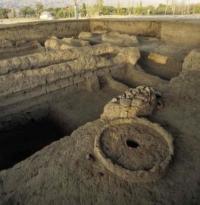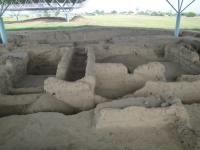Вы здесь
Ancient of Sarazm




Trip on settlement Sarazm.
As happens quite often, an accidental find gave impetus to a large discovery. It happened this way in 1976 when Ashurali Taylanov, a resident of Avazali village, after visiting a history museum in Panjakent, in formed local archaeologists about his interesting find - a bronze axe, which he found not far from his home and which was very similar to the one he saw in the museum (a bronze axe which had been found in the late XIXth century in Yor village, Panjakent district).
Being interested in the local resident's unusual find, scholars decided to research the area in which it was discovered in more detail. In 1977 Tajik archaeologists began a dig in a place which later became known as the site of the ancient agricultural settlement of Sarazm.
French and American specialists joined the works in 1984. The word Sarazm has several etymological interpretations:
a) sar-sabz, i.e. Sari-Sabza ("green beginning"). Perhaps, it refers to the valley that begins in Sarazm heading in the direction of the mountains, in which a variety of greeneries grow;
b) from an Arabic word Sarrazm ("beginning of battle"). Residents of upper Zarafshon first met their en emies in Sarazm and fought back;
c) from the Sogdian Sari-Zamin, ("beginning of the land"). Sarazm divides the Zarafshon valley into flat and mountainous parts.
The settlement consists of a hill 400 - 800m wide, stretching about 1,5km from east to west, situated on a terrace of the left bank of the River Zarafshon. The total area of the site is more than 100 hectares.
In the northern and western parts there are now the villages of Sa-hibnazar and Gurach, and in the north-eastern part Ava-zali. Crops are grown on a significant portion of this site. The part of Sarazm which remains undisturbed is about 30 hectares.
Research gives grounds for the opinion that the ancient settlement existed here for about one and a half millennia from 3,400 - 2,000 B.C. Numerous houses, religious buildings and palaces were excavated in Sarazm.
A great number of articles made of copper, bronze, lead, silver and gold, weaponry, and ornaments of the 4th - 2nd millennium B.C. were found. Site of ancient Sarazm. Flattening iron. Stone. Second half of the 3rd millennium B.C.
Some of the finds allow us to understand the rather high social status of women in the settlement at that time. In one burial ground opened by scholars a woman was found buried in clothes decorated with silver, turquoise, cornelian, lapis lazuli, and jasper beads.
Her hair was decorated with gold beads, and her arms with massive bracelets made out of sea shells. All this wealth would not be found in the burial of a peasant. Agriculture, cattle-breeding, metal mining, black-smithery and production of stone goods formed the basis for Sarazm's economy.
Judging by the large number of items related to metal-working found in this site you can conclude that Sarazm was one of the largest metallurgy centres of Central Asia. Fragments of casts, cast crucibles, smelting furnaces, massive tampers, ore-crushing hammers, and metal goods including axes, daggers, knives, lance-heads, pins, fishhooks, knitting needles, razors and decorations were found here.
Copper ore and other bronze production components were most likely home-produced from deposits situated 40 - 50km east of the site. Stone cutting was widely developed in this site. Beads and pendants made from agate, onyx, obsidian, lapis lazuli, turquoise, and cornelian found during a dig serve as evidence of the high level of this art.
There were some unique finds among them, such as a stone baton with a rostral head and an opening for a rod and a clay stamp. Such stamps were found in some ancient monuments of Mesopotamia, Iran, Baluchistan (Pakistan) and India.
A palace complex occupying more than 250ml and consisting of an entrance corridor, a lobby, two-three rooms and several auxiliary structures was excavated in Sarazm. All the buildings are connected by wide corridors with clay doorsills.
In one of the complex walls there are windows for light and ventilation similar to those seen in bronze age monuments in South Turkmenistan, South Afghanistan and North Baluchistan.
However, a distinctive feature of the Sarazm complex is the existence of circular altars in the centre of two of the rooms which do not exist in the other monuments. Perhaps it was not simply a palace but also a place for devotions.
Archaeologists always considered ceramics and particularly their method of production as one indicator of the level of development of primitive communities. Most ceramic goods found in Sarazm were hand-made and baked in furnaces nearby.
Altogether 6 furnaces were discovered, in which 12 forms of containers (goblets, rummers, bowls, jugs, etc.) were baked, and this shows quite a high level of development of ceramics there.
Some goods, mainly kitchenware, were decorated with paintings similar to those found on early agricultural ceramic artefacts from the Middle East, South Turkmenistan and Afghanistan.
All these many and various finds serve as evidence of the wide trade and cultural ties between the tribes that lived in the Upper Zarafshon valley and South-East Turkmenistan, South-East Aral area, the Middle East, and the Indus River valley tribes.
Authorship:
Javad Abed Khorasani. http://www.asraresokhan.com
Alexander Petrov
photos.







